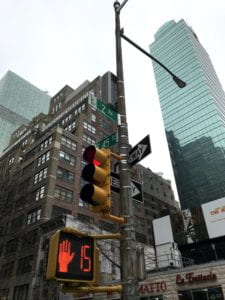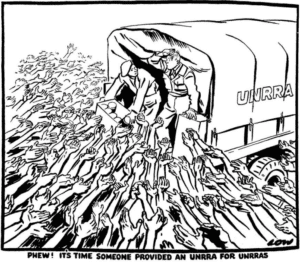 In this post you can read about the UNRRA documents concerning refugees and displaced persons in China after World War Two, some practical advice, as well as my general impressions about the UN Archives.
In this post you can read about the UNRRA documents concerning refugees and displaced persons in China after World War Two, some practical advice, as well as my general impressions about the UN Archives.
It isn’t quite the same to visit an archives in the skyscraper jungle of Manhattan than going to the ones that sit imperiously in the more flat and spread-out parts of Mainland Chinese cities. Unlike the massive yellow-tiled Municipal Archives of Tianjin between a university campus and a large waterpark or the Second Historical Archives that nestles is the old Ming palace of Nanjing, the metropolitan surroundings of the UN Archives in New York have more common with the Shanghai Municipal Archives. But while in the Pearl of the Orient the tired researcher’s wondering eyes can gorge on the colonial facades of the Bund and the modern towers of Pudong across the Huangpu, for the visitors of the UN Archives it’s a 300 m walk to reach the East River where the flat box of the UN Headquarters is soaring high.

United Nations Headquarters in New York City, view from Roosevelt Island (Wikipedia)
Whenever I mention my destination to friends in these days, they would get excited and imagine that I work in the building you can see on the picture above (box on the left). Actually, the place I’ve been frequenting in the past couple of weeks is much more humble than the famous edifice guarded by the 193 member states’ national flags. The place I go is hiding behind a little glass side door on 45th street between the 2nd and 1st Avenues. You need to buzz in to enter a low ceiling reading room, usually populated by one or two fellow researchers and the archivist sitting behind their computer. It’s not that majestic, but the smooth course of the service and the kind and helpful attitude truly make up for the modest interior.
Find the little glass side door…
the reading room (L); lockers in the background (M); reading desks and document lamps in the background (R)
But what am I doing in here after all? It is the UNRRA (United Nations Relief and Rehabilitation Administration) documents that I’m after, more specifically the relief and repatriation efforts of other this and other UN-related projects including the CNRRA (Chinese National Relief and Rehabilitation Administration) and the IRO (International Refugee Organization). All these acronyms-bearing organizations were actively assisting both domestic and foreign displaced persons (DP) in postwar (WWII) China. Much information about the Central European diaspora communities, including Jewish and non-Jewish refugees and emigrants can be found in the official correspondence and registration documents, mostly related to the individual applications for food, clothing or financial relief in Chinese cities, or the requests to be repatriated. In order to prove eligibility for such assistance, one had to prove their non-collaborant record i.e. that they never collaborated with neither the Nazi German nor the Imperial Japanese authorities during the war. Foreign emigrants were required to form associations usually based on their respective ethnicities, that represented their interest and dealt with the UNRRA and the local Chinese authorities. All the above mentioned records are potentially interesting and relevant to my dissertation project, as they offer valuable sources to the final phase in most Central European refugee’s stay in Republican China.

David Low’s 1946 Caricature about the difficulties of UNRRA relief efforts (cvce.eu)
Finally, some practicalities for those who wish to visit. The UN Archives is open for anyone and the registration process is also fairly simple and straightforward. Before you visit, I suggest to consult their online catalogue where you can also find the exact call numbers you will need to make requests. Once you know more or less what you’re looking for, contact the archivist via email, who then will send you the registration and request forms. The request usually goes through very quickly, it is possible to view your documents as early as the following day. You only need to make sure you reserve a seat in the reading room in advance, which you can do also via email. When in the archives, registration has to be completed by the archivist, who’ll ask you for your ID/passport. Then you can take your seat at one of the desks, place your belongings in one of the lockers (they provide locks for free) and wait for your documents to arrive. You can take photos without any limitations, use your laptop and their reliable wifi service.
Address: 304 East 45th Street, New York, NY
Opening hours: Monday – Friday from 9:00 am to 4:30 pm.






Leave a Reply
You must be logged in to post a comment.